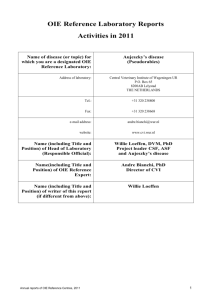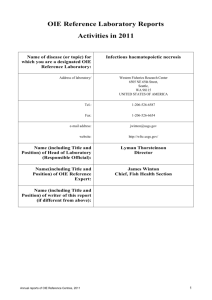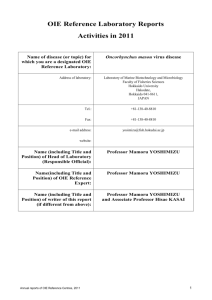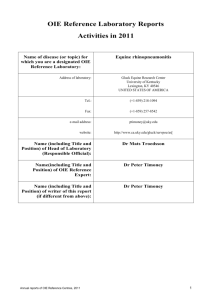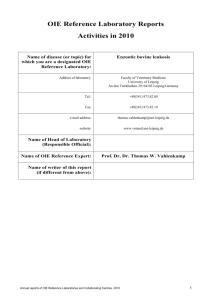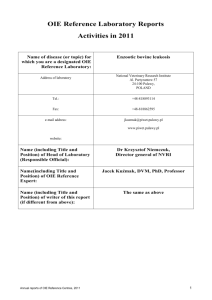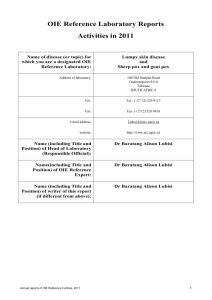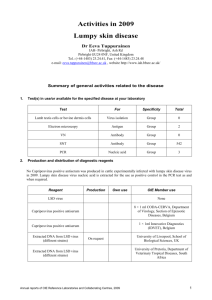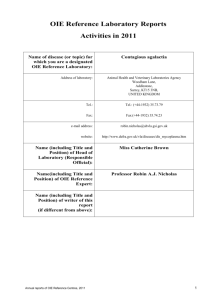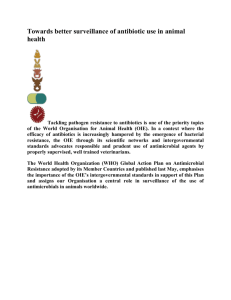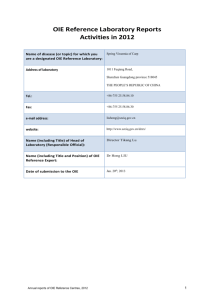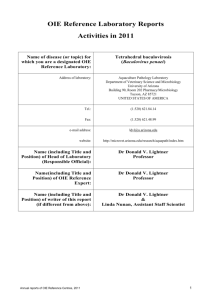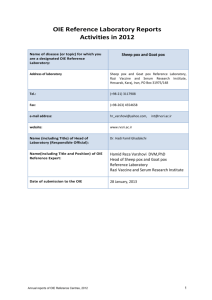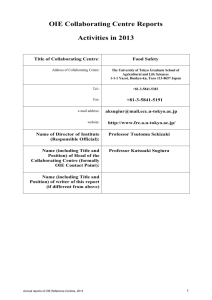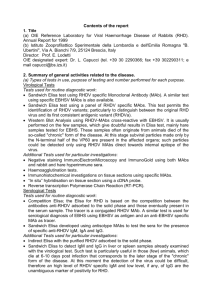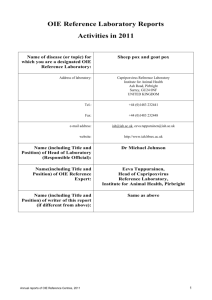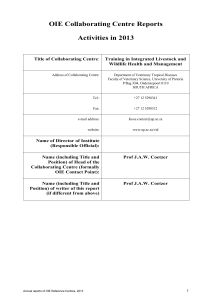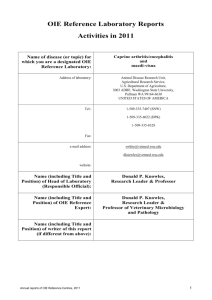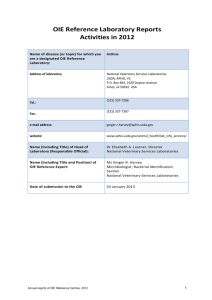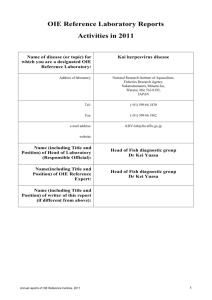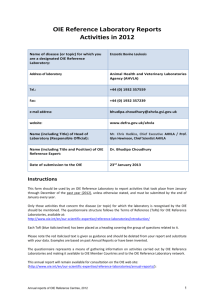Disease name
advertisement
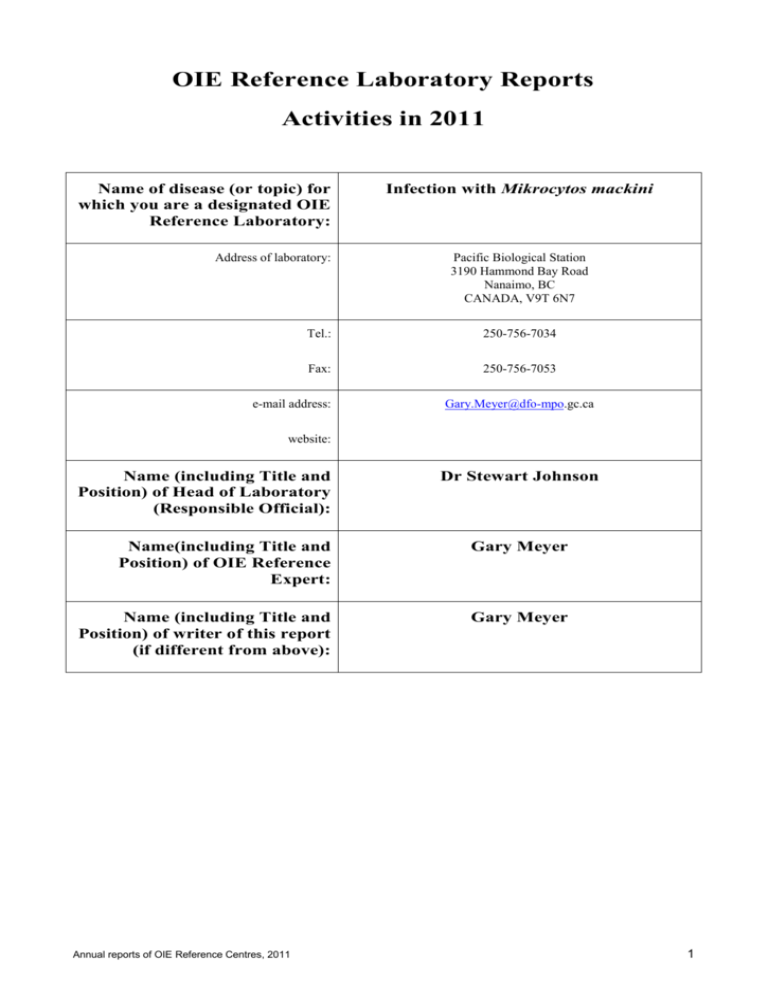
OIE Reference Laboratory Reports Activities in 2011 Name of disease (or topic) for which you are a designated OIE Reference Laboratory: Address of laboratory: Infection with Mikrocytos mackini Pacific Biological Station 3190 Hammond Bay Road Nanaimo, BC CANADA, V9T 6N7 Tel.: 250-756-7034 Fax: 250-756-7053 e-mail address: Gary.Meyer@dfo-mpo.gc.ca website: Name (including Title and Position) of Head of Laboratory (Responsible Official): Dr Stewart Johnson Name(including Title and Position) of OIE Reference Expert: Gary Meyer Name (including Title and Position) of writer of this report (if different from above): Gary Meyer Annual reports of OIE Reference Centres, 2011 1 Infection with Mikrocytos mackini Part I: Summary of general activities related to the disease 1. Test(s) in use/or available for the specified disease/topic at your laboratory Test 2. For Specificity Total Histology Parasite visualisation Group 1200 Tissue imprints Parasite visualisation Group 0 PCR Molecular test Group 800 qPCR Molecular test Type (Currently undergoing validation) 3000 DIG-ISH Molecular test for parasite visualisation Group 0 Electron microscopy Parasite visualisation Type 0 Production and distribution of diagnostic reagents The reagents required for light microscopy and the molecular tests are available commercially. Positive control samples are available to diagnostic laboratories and researchers in all OIE Member Countries upon request. Positive control samples are used with each batch of tests performed in our laboratory. Part II: Activities specifically related to the mandate of OIE Reference Laboratories 3. International harmonisation and standardisation of methods for diagnostic testing or the production and testing of vaccines a) Establishment and maintenance of a network with other OIE Reference Laboratories designated for the same pathogen or disease and organisation of regular inter-laboratory proficiency testing to ensure comparability of results Not applicable. b) 2 Organisation of inter-laboratory proficiency testing with laboratories other than OIE Reference Laboratories for the same pathogens and diseases to ensure equivalence of results 1. Proficiency test panels for histological detection of M. mackini were developed for Canada’s National Aquatic Animal Health Laboratory System (NAAHLS). 2. Reproducibility of a new qPCR test (see section 5) is currently being assessed with participation from CSIRO’s Australian Animal Health Laboratory in Geelong, and two labs within Canadian National Aquatic Animal Health Laboratory System (Gulf Fisheries Centre in Moncton, NB, and Freshwater Insitute in Winnipeg, MB). This is being organized by C. Abbott at the Pacific Biological Station (the OIE reference laboratory). Annual reports of OIE Reference Centres, 2011 Infection with Mikrocytos mackini 4. Preparation and supply of international reference standards for diagnostic tests or vaccines Histological sections and DNA tissue samples of Pacific oysters (Crassostrea gigas) from British Columbia infected with M. mackini were supplied as reference standards to the following laboratories: 1. 5. Mrs. Cara Brosnahan, Ministry of Agriculture and Forestry, National Centre for Bio security and Infectious Disease Campus, 66 Ward Street, Upper Hutt, 5018, New Zealand. Research and development of new procedures for diagnosis and control Development of a new TaqMan qPCR assay specific to M. mackini has been completed and full diagnostic validation following OIE guidelines is in progress. The assay targets the ITS2-28S region of M. mackini rDNA and can detect as little as 65 copies of a plasmid containing the target sequence in a matrix of host tissue. Assay specificity was confirmed by the absence of amplification in Mikrocytos sp. and a broad range of other shellfish pathogens and commercially important shellfish hosts. Due to the focal nature of infections, qPCR sensitivity was evaluated across several tissue types, which were selected based on historical observations of the distribution of infections in the host. Tissue types sampled were: mantle; palps; adductor muscle; a mid-body cross section including gill, digestive gland, mantle, connective tissue, and gonad; and hemolymph from 62 Pacific oysters. Statistical analyses of qPCR results from the five tissue types of positive individuals showed that the mid-body slice was the optimal tissue to sample for detection of M. mackini by qPCR. Performance characteristics of the assay (diagnostic sensitivity and specificity) will be derived this year from data generated from over 700 oysters. Repeatability and reproducibility are also being measured following OIE guidelines. 6. Collection, analysis and dissemination of epizootiological data relevant to international disease control Dr. Ralph Elston (Aqua Technics, 455 W. Bell Street, Sequim, WA USA 98383) detected M. mackini in Kumamoto oysters (C. sikamea) from Humboldt Bay California in February 2011 using histology and conventional PCR techniques; which represents a new host record and extension of the geographical range. Denman Island Disease in Kumamoto Oysters – Impact and Management. Abstract and presentation by Dr. Ralph Elston at the Pacific Coast Shellfish Growers Association and National Shellfisheries Association Meeting in Salem, Oregon, USA in September 2011. 7. Maintenance of a system of quality assurance, biosafety and biosecurity relevant to the pathogen and the disease concerned Canada’s National Aquatic Animal Health Program (NAAHP) lists Mikrocytos mackini as a reportable disease. The National Aquatic Animal Health Laboratory System (NAAHLS) is in the process of implementing a quality assurance and management system designed to the internationally recognized standards of ISO / IEC 17025:2005. 8. Provision of consultant expertise to OIE or to OIE Member Countries Provided an updated chapter to the OIE on infection with Mikrocytos mackini for the 2012 Manual of Diagnostic Tests for Aquatic Animals. 9. Provision of scientific and technical training to personnel from other OIE Member Countries None in 2011. 10. Provision of diagnostic testing facilities to other OIE Member Countries On one occasion (August 2011) provided confirmatory testing (qPCR and DNA sequencing of 18S and ITS genes) on samples that originated from the USA which further confirmed the presence of M. mackini in Kumamoto oysters (C. sikamea) collected from Humboldt Bay , California in February 2011. Annual reports of OIE Reference Centres, 2011 3 Infection with Mikrocytos mackini 11. Organisation of international scientific meetings on behalf of OIE or other international bodies None in 2011. 12. Participation in international scientific collaborative studies None in 2011. 13. Publication and dissemination of information relevant to the work of OIE (including list of scientific publications, internet publishing activities, presentations at international conferences) Presentations at international conferences and meetings Lowe G., Meyer G., Abbott M.G., Johnson S.C., Abbott C.L. Development of qPCR assay for Mikrocytos mackini and assessment of optimum tissue for diagnostic testing. European Association for Fish Pathologists International Conference, 12-16 October 2011, Split, Croatia. Scientific publications in peer-reviewed journals Abbott C.L., Gilmore S.R., Lowe G., Meyer G. & Bower S. 2011. Sequence homogeneity of internal transcribed spacer rDNA in Mikrocytos mackini and detection of Mikrocytos sp. in a new location. Dis. Aquat. Org., 93, 243250. Other communications An Overview of Past and Present Research on Denman Island Disease (Mikrocytos mackini). Abstract and presentation by Gary Meyer at the Pacific Coast Shellfish Growers Association and National Shellfisheries Association Meeting in Salem, Oregon, USA in September 2011. _______________ 4 Annual reports of OIE Reference Centres, 2011
